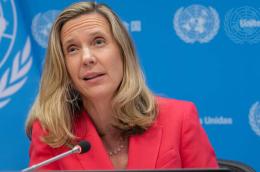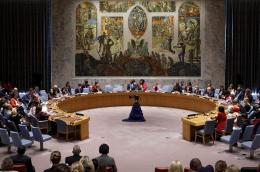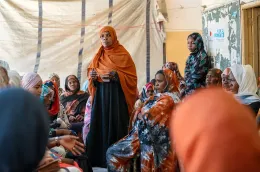Women's Leadership
Main navigation
NEW YORK CITY: Twenty-five years after the adoption of UN Security Council Resolution 1325, which committed world leaders to advancing the inclusion of women in peace and security processes, a new UN report reveals a troubling reversal of progress.
While global military spending is surging and armed conflicts are intensifying, women are increasingly shut out of peace processes.
“Despite the promise and the engagement around Resolution 1325, military spending is at record levels, gender equality is under attack, and multilateralism is weakening,” said Nyaradzayi Gumbonzvanda, the deputy executive director of UN Women.
“Last year, 87 percent of peace talks took place without a single woman at the table,” she said, at a time when the world is seeing more conflicts than at any time since the Second World War, with devastating consequences for women and girls.
According to the report, nearly 700 million women and girls now live within 50 kilometers of armed conflict, the highest number since the 1990s. Civilian casualties among women and children have quadrupled over the past two years, while conflict-related sexual violence has increased by 87 percent.
VIENNA, 18 June – The OSCE Forum for Security Co-operation placed the Women, Peace and Security agenda at the forefront of its programme today, with a dedicated Security Dialogue during the plenary session and a side-event focused on gender-responsive security.
The Security Dialogue, held under the theme “The Role of Women in Strengthening Defence and Ensuring Resilience”, brought together expert panellists from Estonia, Sweden, and France. Discussions emphasized that women’s meaningful participation enhances operational effectiveness and community trust in defence institutions. As global threats evolve—from armed conflict to cyber warfare and climate-related disasters—harnessing the full potential of women in defence is not only a matter of equity but of strategic necessity.
“Inclusive national security institutions that integrate women at all levels of society are more operationally effective, community-responsive and resilient,” said Ambassador Kaja Tael, Permanent Representative of Estonia to the OSCE and Chair of the FSC.
In October 2025, the UN community will mark the 25th anniversary of UN Security Council Resolution 1325, which launched the women, peace, and security (WPS) agenda. Since 2019, IPI has analyzed challenges and successes in increasing uniformed women’s meaningful participation in peace operations as part of its partnership with the Elsie Initiative for Peace Operations, contributing to a global community of practice that provides evidence-based research on gender and peacekeeping. Over the past six years, this research has explored a range of topics related to women in peace operations, highlighting gaps and offering actionable recommendations for the implementation of the WPS agenda.
IPI in partnership with the Elsie Initiative for Women in Peace Operations (led by Global Affairs Canada), the Stimson Center, the Latin American Security and Defence Network (RESDAL), and the Gender and Security Sector (GSS) Lab, cohosted a hybrid policy forum on October 9th on “Reflecting on 25 Years of the WPS Agenda: Lessons Learned from Gender Research and UN Peace Operations.
-
Despite notable normative advances, after 25 years, the effectiveness of the Women, Peace and Security Agenda is threatened by a fragmented global panorama and faces significant challenges and setbacks.
-
In the new context, the following stand out: (a) the increased frequency and complexity of armed conflicts; (b) the rise of ‘anti-gender’ movements and the erosion of women’s rights in many regions; (c) geopolitical divisions, which make it difficult to prioritise comprehensive solutions to conflicts; (d) the Agenda’s funding crisis; (e) the crisis of multilateralism; (f) the reduced representation of women as negotiators and mediators; and (g) the loss of policy coherence and its transformative potential due to the instrumentalisation of the Agenda, often used for geopolitical purposes.
-
For the Agenda to remain relevant, it is crucial that it evolves and adapts to the new global situation and updates its principles with an understanding of the local contexts in which it must be applied.
In 2000, the United Nations Security Council recognized that women’s leadership and gender equality are crucial for international peace and security, and the past 25 years have seen increased attention to this matter. However, the rise in global conflict in recent years risks erasing the modest progress made in previous decades.
Every year, the UN Secretary-General presents an annual report to the Security Council detailing the status of the women, peace and security agenda in the world. This year’s report contains more than one hundred facts and figures on issues ranging from women’s participation in peace processes, peace operations, or politics in conflict-affected countries, to the impact of conflict on women and girls, including atrocities that target them disproportionately, like reproductive violence, gender-based persecution, or conflict-related sexual violence.
This infographic, prepared by UN Women, highlights a few of these facts and figures, along with recommendations to change course.
New York, 20 October – The world is experiencing the highest number of active conflicts since 1946, creating unprecedented risks and suffering for women and girls.
The 2025 UN Secretary-General’s report on Women, Peace and Security warns that 676 million women now live within 50 kilometers of deadly conflict, the highest level since the 1990s. Civilian casualties among women and children quadrupled compared to the previous two-year period, and conflict-related sexual violence increased by 87 per cent in two years.
Issued on the 25th anniversary of Security Council resolution 1325, which committed the international community to women’s full participation and protection in peace and security, the report warns that two decades of progress are unraveling.
“Women and girls are being killed in record numbers, shut out of peace tables, and left unprotected as wars multiply. Women do not need more promises, they need power, protection, and equal participation”, said Sima Bahous, UN Under-Secretary-General and UN Women Executive Director.
Despite overwhelming evidence that women’s participation makes peace more durable, women remain largely excluded from decision-making. While an increasing number of countries have developed national action plans to implement resolution 1325, this has not always resulted in tangible change for women. In 2024, 9 out of 10 peace processes had no women negotiators, with women making up just 7 per cent of negotiators and 14 per cent of mediators globally.









